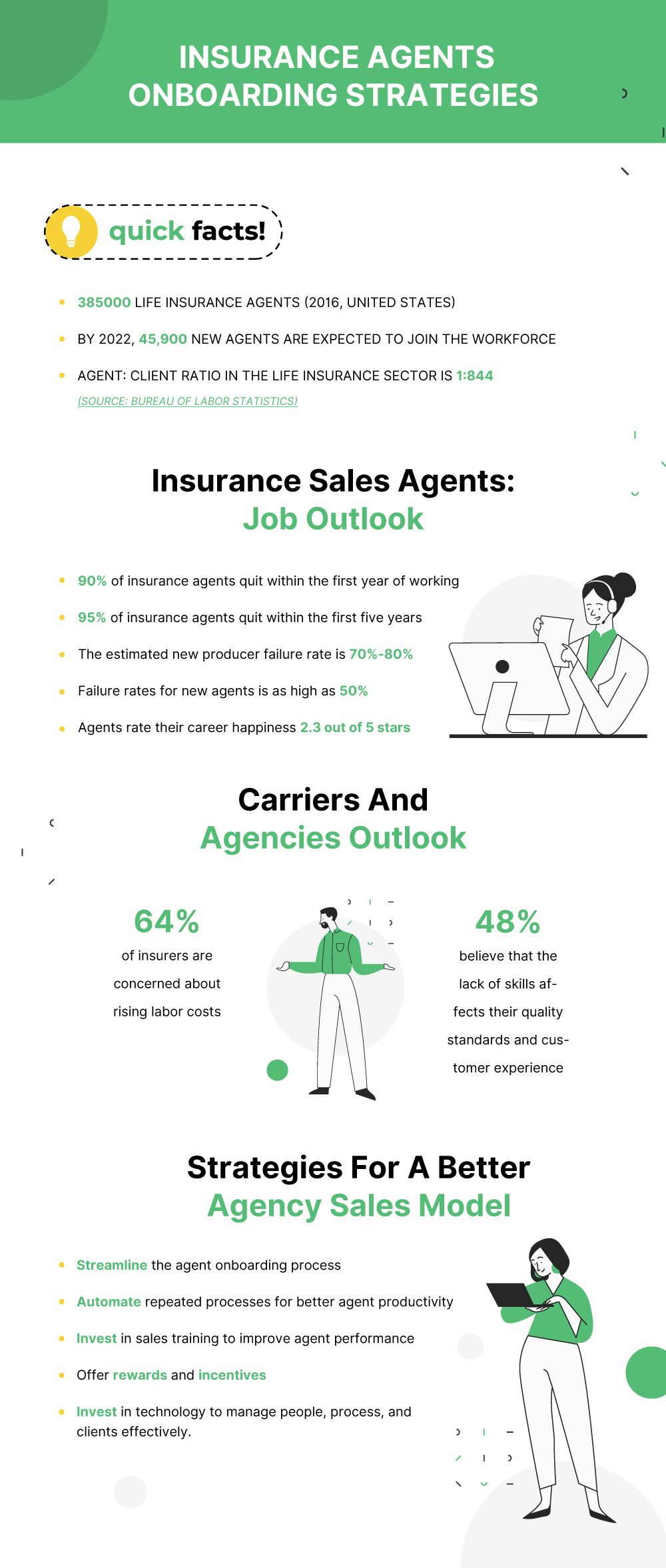According to the Bureau of Labor Statistics (BLS), there were over 385,000 life insurance agents in the United States in 2016, and by 2022, another 45,900 will enter the market. With the U.S. population just over 330 million as of April 2021, the life insurance industry provides one agent for every 844 people. However, unfortunately, almost 90% of insurance agents leave their carriers to pursue other opportunities outside the industry. While this makes insurance agent onboarding a routine activity, a smooth onboarding experience can help carriers and agencies retain agents for a longer time.
Therefore, investing in sound and strategic agent journeys, from onboarding to ongoing engagement and beyond, can increase the agent success rate and can certainly impact your bottom line.
Young insurance agents believe that the industry has been too slow to adopt new technology. As found by Statista, over 63% of the respondents believe that the United States insurance industry needs to adapt to growing technological changes. It indicates the expectations of the young insurance agents getting onboarded. What’s worse is that the burnout rate for life insurance agents is higher than most other occupations. With more than 90% of the agents quitting within the first year. This percentage only increases with time as 95% of insurance agents leave within five years.
As they say, the beginning is the most important part of the work. A great onboarding experience will help develop a positive perception of your agency. And it can also contribute to reducing the agent churn rate.
So, what are the steps of a smooth insurance agent onboarding process?

1. Automating the application process
Automation can significantly improve the onboarding experience for agents. Agents can apply online, where candidates can enter their information and upload their documents for verification. You can also specify the eligibility criteria, forms required (specific to the type of insurance sales they’re applying for), and more. Your onboarding team can shortlist and add new agents easily by collecting, uploading, and syncing documents digitally. This cuts down the long-winded process of sending out applications and going through them manually. Instead, your onboarding team can do it digitally and don’t have to sift through information; all of it will be uploaded onto a single platform.
2. Verification of documents
As soon as your onboarding team adds an agent to the system, you can automatically distribute their information and documents to the verification team. It is possible with onboarding tools such as LeadSquared. Here, you can create workflows as per your onboarding process. For instance, once the verification team approves the candidature, the system can notify the applicant about the update and send a message/email for the next step of the onboarding process. There are two clear benefits of using such systems. One – the document is stored in the cloud and is accessible to everyone. And two, once the candidate is shortlisted, they need not upload the copy of the same documents again while onboarding.
3. Different onboarding forms for various insurance sectors
Your insurance agent onboarding team can create different application forms for different kinds of insurance, such as life, property, automobile insurance, and more. This helps the onboarding team to segregate and allocate agents to their specific teams. Also, they reduce the time spent distributing trainers and material to each agent. Dynamic forms simplify their work by showing only the fields that are needed for their vertical. This provides a clutter-free environment for the team while onboarding a new agent. It also decreases the risk of manual error, and speeds up the application process. According to the roles available, your onboarding team can customize the criteria to fit current insurance agent skills and qualities required.
4. Checking person-environment fit
Before wrapping up the hiring process, a crucial step is to always check the person-environment fit. Especially in a field as difficult to find success in as an insurance agent. This means administering a personality scale of the test to the prospects during their application process to ensure that they can deal with difficult situations. In a report by the insurance journal, Chris Burand, president of Burand & Associates, an insurance agency consulting firm, estimates that the new producer failure rate is as high as 70% to 80%. Other estimates have pegged failure rates for new agents as high as 50%. Making it vital to hire agents who aren’t easily swayed by rejections and can withstand difficult circumstances. Once hired, to reduce such estimations, the next important step is training.
5. Training for tough times
According to recent insurance statistics, 64% of insurers are concerned about rising labor costs. And 48% believe that the scarcity of key skills affects their quality standards and the customer experience. This means that insurance agents don’t have the skills needed to tackle sales situations that come their way. Training agents to have large amounts of knowledge about the product is definitely important. It is especially crucial for agents working in insurance agencies to be aware of a range of insurance products from different carriers.
You can also introduce the buddy system to newly onboarded agents who can socialize and learn from each other’s experiences. This also gives them a chance to connect with members of their department. As your agent information is readily available and well organized. However, in the insurance industry, what makes a difference between a good and bad insurance agent is their interpersonal skills. Investopedia outlines the qualities that make a good insurance agent, and their first three requirements are all soft skills. Your insurance agent onboarding team and its trainers should make it a point to not only train them in terms of product knowledge, but also train the agents in their ability to establish a rapport with customers and create a sense of enthusiasm and positivity in their sale.

6. The need for rewards and incentives
If you’ve noticed, throughout this article, the pattern is pretty clear. Insurance agents struggle to find happiness in their occupation. This may be for multiple reasons. But one thing every insurance agency can invest in is its rewards and incentives program. According to a study by CareerExplorer, insurance sales agents rate their career happiness 2.3 out of 5 stars. This means that insurance agents quit not only because of repeated failure but also because of the lack of general job satisfaction. Therefore, insurers and agencies must create rewards and incentives for high achievers and help agents who need a nudge in the right direction.
You can do this with a system that tracks their performance and provides you with reports and information that detail the customer’s journey in their sales funnel. Insurance agent onboarding doesn’t end when they get onboarded. The smarter option would be to train, reward, help consistently, and encourage agents to push past initial failures and rejections. Time spent training can help reduce the time spent in onboarding new agents due to the lack of training and support that caused agents to drop out in the first place.
Insurance agent onboarding checklist
Here are some steps you can take when onboarding new insurance agents–
- Create an employee starter pack with all the necessary documents including contract details, bank account details, job description, and more.
- Introductions are key- be it with colleagues, supervisors, or customers, let your agents familiarize themselves with their new environment. Introduce the buddy system or let one of the senior agents mentor the newly onboarded agent as part of their training.
- Plan and strategize your onboarding by communicating with supervisors. Let your agents gain a strong understanding of your organization’s goals and responsibilities, and train them accordingly.
- Policies and safety requirements: before your onboarding process ends, make sure to keep your agents informed and aware of the company policies and safety measures. Do this to prevent any future errors in regards to company safety.
Going back to the initial statistics of 63% of insurance agents believing that agencies need to adopt better technology for greater productivity, imagine having access to software that performs all the steps for insurance agent onboarding, management, and sales in a single platform. If you’re looking for one such platform, try LeadSquared’s CRM!
Also read:









